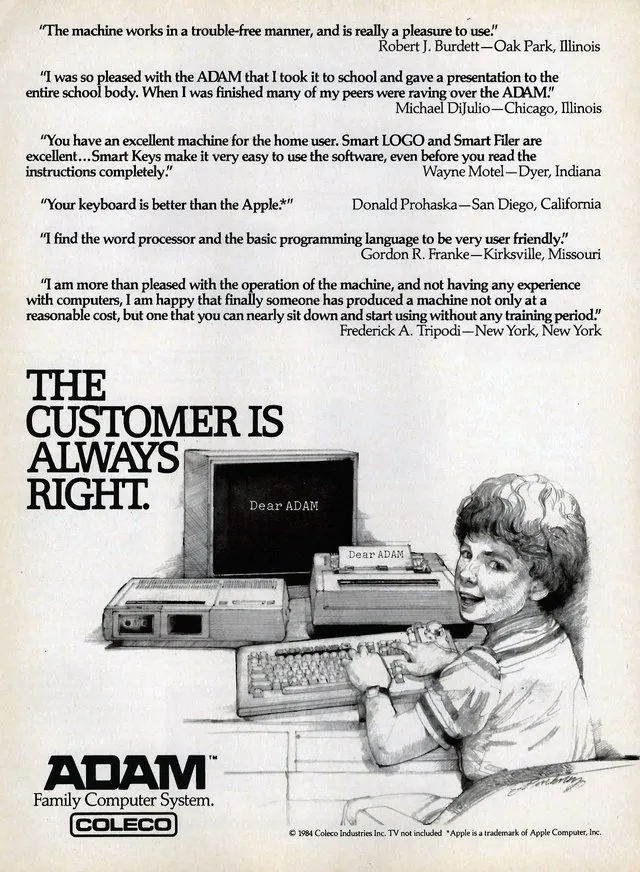
This ad for the Coleco ADAM came out circa 1985. It's quite possible that the ADAM had already been discontinued by the time people saw this ad though stock would no doubt still been available. The ad is pretty simple and just contains quotes, presumably from real customers, praising the ADAM. Given the history of the ADAM, it's reasonable to wonder how many more complaints there were.
The Coleco ADAM was eagerly anticipated but never lived up to its promises. Production delays, reliability problems and some questionable design decisions added up to a disastrous release for Coleco. There were also a number of positive things to say about it but they just could not overcome the bad.
The first problem was production delays. Originally, the ADAM was supposed to ship in August 1983. After several delays, only a limited number shipped before Christmas and many were defective. Essentially missing the Christmas season was devastating to the success of the ADAM.
Hand in hand with the production delays were reliability problems. Initially, many of the problems were with the included printer. There were also issues with tapes being wiped when left in the drives when the system was powered on. Despite the production delays, these and other problems were still experienced by users.
Finally, some poor design decisions combined to make the system less reliable and less desirable. To be fair, some of them were reasonably good ideas at the time of design but the pace of technological advancement caused some of those decisions to be outdated, especially given the lengthy production delays.
First was the decision to power the computer through the printer. I suppose this reduced the number outlets needed and may have helped reduce cost but the downside was that if your printer wasn't working, then neither was your computer.
Another questionable decision was using custom high speed tape drives as the primary method of storage. At the time the ADAM was being designed, cassettes or ROM cartridges were still the primary means of data a program storage for most people. The cassette drives that Coleco used were much higher speed but more expensive and less reliable. More importantly, disk drives were rapidly replacing cassettes as the primary means of storage for most people by the time the ADAM was actually released. A disk drive was eventually produced for the ADAM but it was really already too late.
Finally, the inclusion of a built-in word processor and booting directly into it was a mixed bag. In some ways the idea was ahead of its time. Many computers of the time either booted directly into BASIC or included BASIC but no applications. In the early days of home computing it was expected that users would write some of their own software. However, the market was rapidly becoming application driven and people were buying computers to use ready made software. On the other hand, it would be much better to include the software on media vs. including it in system ROM. The word processor was adequate but simplistic and it isn't unreasonable to think that people would want to use a better product. The option to boot into the built-in word processor then become irrelevant and maybe even inconvenient. Commodore aldo tried a similar idea with the Plus/4 and it was a complete failure.
There were a number of good things about the ADAM. It had a fairly large library of games upon release because it was compatible with the ColecoVision. It was relatively inexpensive, only slightly more expensive than a similarly equipped Commodore 64. A ColecoVision could also be upgrade to a full ADAM computer at a reduced cost. However, none of these things could make up for the problems of the ADAM.